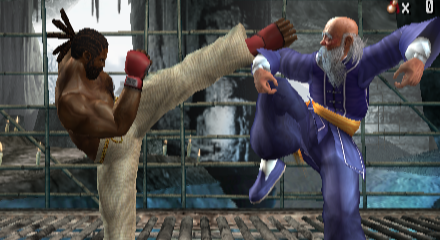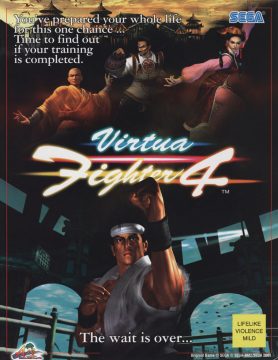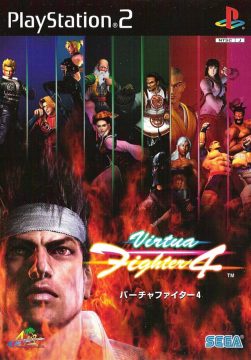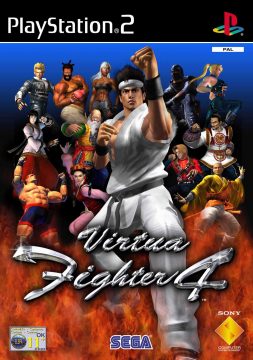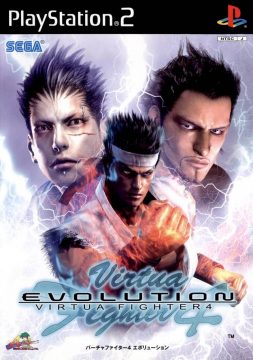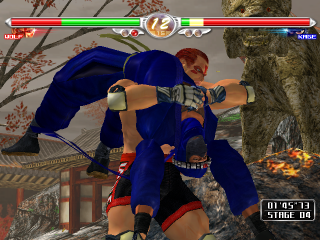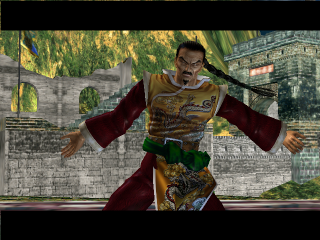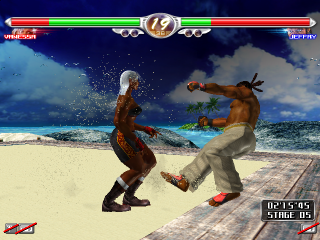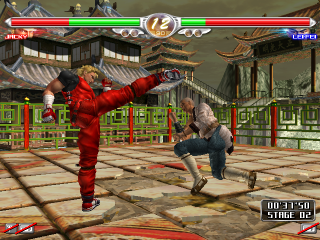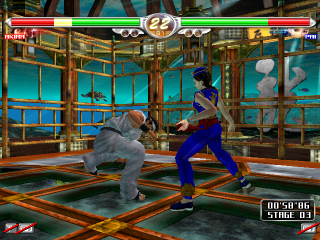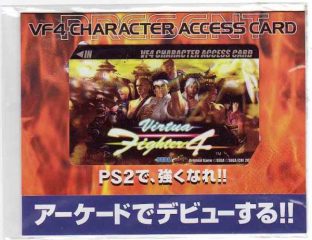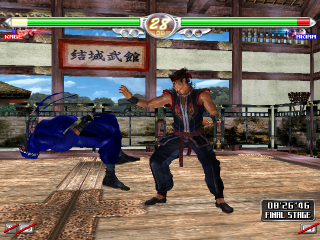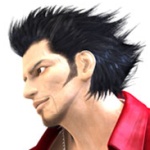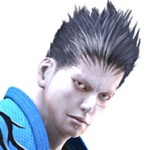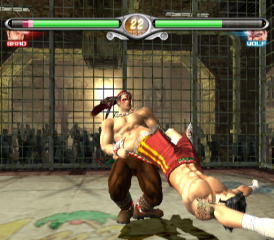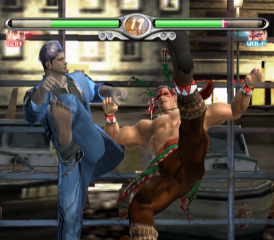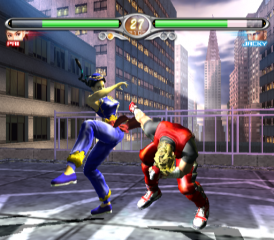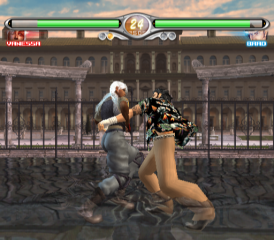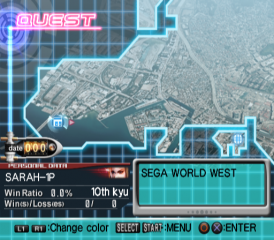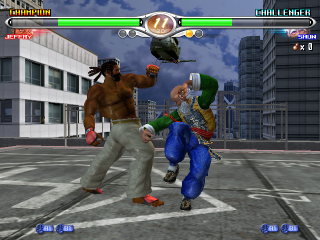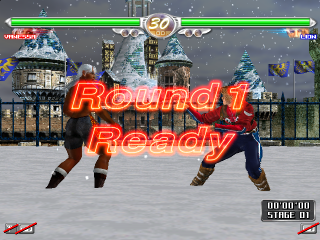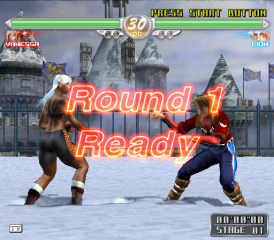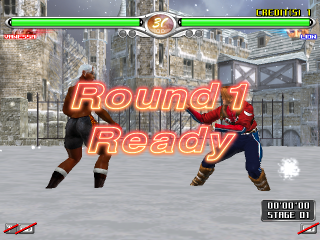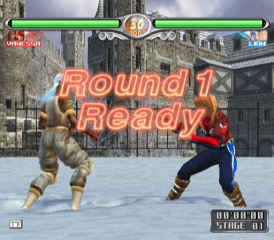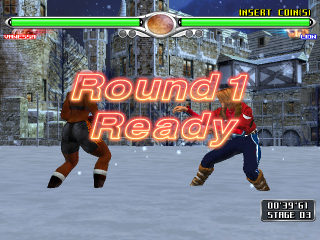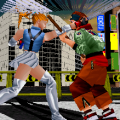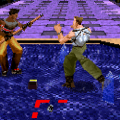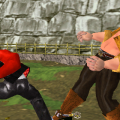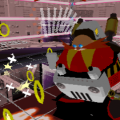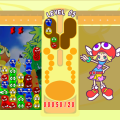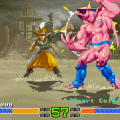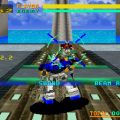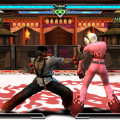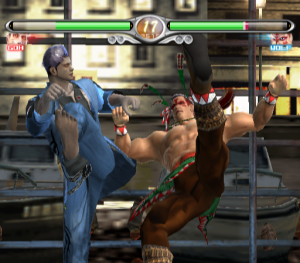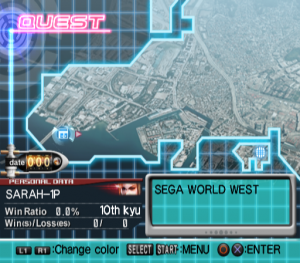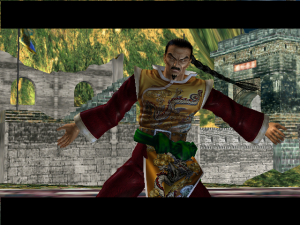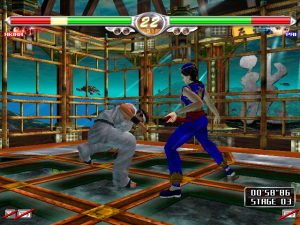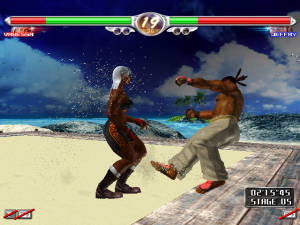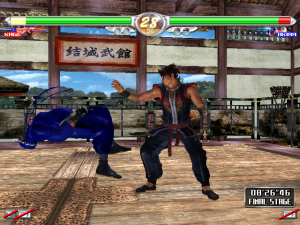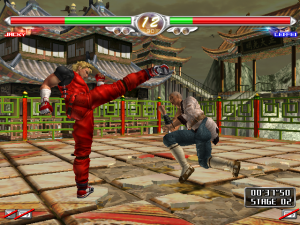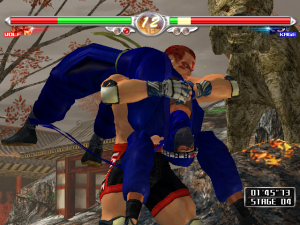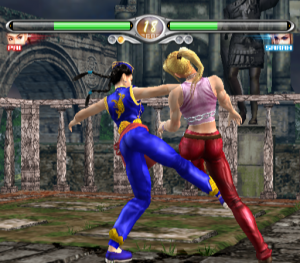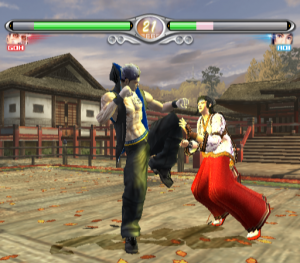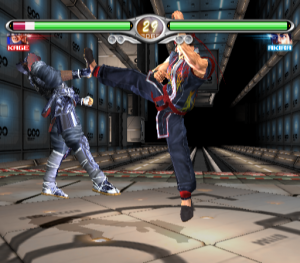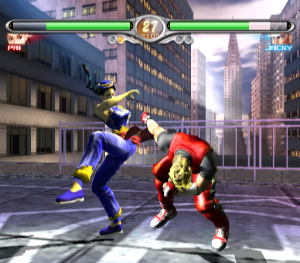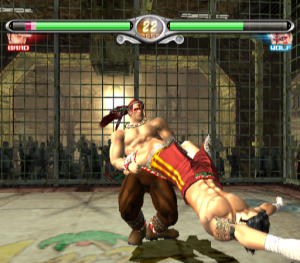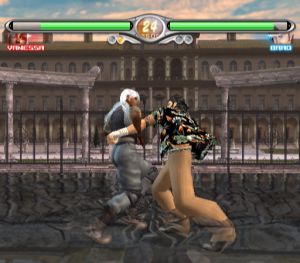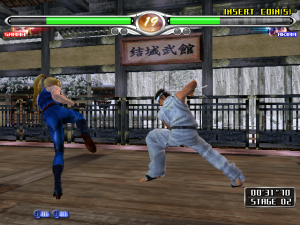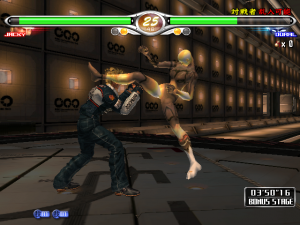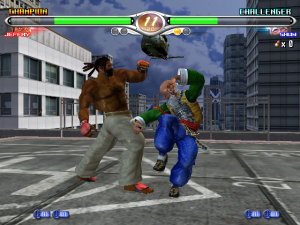Between myriads of merchandise articles, spin-offs and the home port of Virtua Fighter 3, it took AM2 five long years to come up with another full-fledged arcade sequel. Yet the fourth major entry in the series was certainly more conservative than Virtua Fighter 3 had been. In fact, the sequel decidedly went into different directions on multiple accounts: Gone are the more complex environments and the dodge button, but neither went without some form of replacement.
The same dodge maneuvers from Virtua Fighter 3 are still intact, but this time AM2 went for a more intuitive control method. The evasive maneuvers are now initiated simply by double-tapping up or down, while pressing up once initiates full 8-way walk around the arena (jumping is now only even possible as part of aerial attacks). Defensive play in general has become more advanced, as its now easier to escape the often devastating throws, and the commands for reversals are more standardized, yet still a far cry from Dead or Alive levels of simplicity. The game also introduces so-called Sabaki, which are basically offensive reversals that don’t leave you with a useless movement should the opponent happen to not carry out the anticipated attack. Sometimes characters end up stumbling when hit, at which time a joystick waggle animation appears on screen, and by imitating this, the player can reduce the stun time.
Stages may be perfectly flat and squared again, but there is one element Virtua Fighter 4 takes over from its predecessor: Fences. These now can actually be used to one’s own advantage by juggling opponents into them, or even fling them over for a ring out, but only with the right type of fence. Depending on the stage, these could be either high or low, as well as breakable or unbreakable. It may sound relieving to not be endangered by ringouts all the time, but walled stages tend to be quite a bit smaller, and the wall bouncing can get pretty annoying, though it’s never as bad as in Dead or Alive 3 onwards.
New Characters
Lei-Fei
Considering their legendary status in martial arts cinema, Shaolin monks are surprisingly rare guests in fighting games. Lei-Fei is here to change that, although he is described as kind of a villain, out to kill Lau because the Shaolin apparently want to exterminate his Tiger Swallow Style. Appropriately for a Shaolin fighter monk, he can switch between several fighting stances that allow different moves.
Vanessa Lewis
Vanessa Lewis is a former mercenary for the Evil Organization, but has now turned against it and serves as Sarah Bryant’s bodyguard. In her first appearance she is able to switch between two fighting styles: Vale-Tudo and Muay Thai. As soon as Brad Burns got introduced in Virtua Fighter 4 Evolution, though, she dropped the latter.
Even graphically Virtua Fighter had turned from a big innovator into “only” a top tier contender. It still looked noticeably better than Tekken 4, which was released just a couple of weeks earlier, but it didn’t have much on the Xbox-exclusive Dead or Alive 3, other than some real-time reflections in Lau’s stage. The once again isolated arenas, now often half hiding the far surroundings behind fences, also make the action feel much less immediate and lively than the more organic brawls in Tomonobu Itagaki’s series.
But the days when arcade fighting games caused jaws dropping around the world were over, anyway. Not only had arcade machines lost much of their headway against PCs and home consoles, 2001 was also the year of Grand Theft Auto III, and people started looking for complex representations of large worlds they could explore, rather than the condensed, illusionary gloss of a 1-on-1 fighter. Virtua Fighter 4 was still one of the best-looking games of its time, it’s just that its visual qualities had stopped being the focus of attention.
The biggest innovation and most pronounced new feature of Virtua Fighter 4 didn’t have anything to do with the mechanics or the technology, but pertained to the social gaming functions. At every arcade, players could purchase a so-called Character Access Card, basically an IC memory card. The idea set a major precedent in Japanese arcades, up to the point where a majority of games would use them a few years later. In Virtua Fighter 4, players were not only able to carry around their fighting statistics, but also win several accessory items, haircuts and clothing modifications for their character. The basic costumes still remained the same two standard types, but what little customization there was went a long way for players to create their individual on-screen identity. Also introduced was an array of ranks loosely based on the traditional Japanese Kyu/Dan system. With this game Sega also launched VF.NET, which is being continued for every subsequent update and allows users to log into an account and manage their data online.
The arcade version of Virtua Fighter 4 ran on a Naomi 2 board, which had gotten a significant power boost over the Dreamcast hardware, but was still reasonably similar. By the time a home release came on the horizon, however, Sega had already ejected itself from the console business, and thus the game was only ever ported to the former competitor PlayStation 2. The graphical differences between the versions were small, although PS2 gamers had to live with some rather nasty jaggies, and the reflections are also gone.
The PlayStation 2 version inherits the customization options of the original, but with no online gameplay, some rather half-assed exclusive single player modes had to stand in as justification for unlocking accessories. The central new mode was called Kumite (why this was left untranslated in the English release is a mystery, as it just means “sparring”), an endless string of customized opponents. Here players earn experience points for ranks and are even awarded an item every once in a while.
Even more questionable is the purpose of the new A.I. System mode. Here the player is responsible as coach of an A.I. Character, which simply consists of sparring with them and watch them improve through some dubious learning process. This might have been an interesting premise in the context of an elaborate career mode, where you train your dude from underdog to champion. But it’s just that – sparring and watching them get better at sparring with you. This may have some merit for determined would-be pros, as it technically simulates a human character reaction to the player’s prefered tactics. But of course it’s much slower and inferior to actual human opponents, and what is the purpose of training for matches if you don’t have anyone to play with?
Aside from all that more or less unnecessary filler, the one really useful new feature is an elaborate training mode. Going way beyond the standard “beat down an invincible dummy until your inputs start to make sense” setup, this mode lets players practice all the commands with on-screen instructions and even demonstrates moves and tactics, in slow motion if needed. For the first time a Virtua Fighter actually reached out to help players getting into the basics of the fighting system, and this alone made the home version worth its price.
A full sequel once again wouldn’t show up until half a decade later, instead AM2 continued tweaking Virtua Fighter 4 to near perfection. After a number of minor revisions, the largest intermediate update yet hit the arcades in 2002 in the form of Virtua Fighter 4 Evolution. The biggest news were the two new playable characters, as were introduced for the first time ever in a sub-update to the series.
New Characters
Brad Burns
Virtua Fighter‘s resident womanizer is also a Muai Thai champion (hence why Vanessa had to give up that career) with lots of fast, fun moves. Of course Brad Burns is from Italy, always gotta keep the stereotypes quota up. When he meets Aoi, there’s a bit of a love/hate relationship played up between the latin lover and the virtuous woman.
Goh Hinogami
The back of Goh Hinogami’s jacket is the first place where you’d read the name J6 if you always skipped the manuals. He’s an assassin from within the organization dispatched to the tournament, and easily the most unapologetically evil and mean-spirited combatant in the series. His designated fighting style is Judo, but of course it’s a very loose interpretation of the sport.
AM2 didn’t stop there: Most of the fighting arenas were also retouched, usually varying the time of day or weather conditions, but some even have major changes to the surroundings, like Lion’s castle stage, which now takes place at another part of the general area. The old characters also got tuned a bit, and there were many more accessories to decorate them with. A solo player was now also presented with several optional objectives like “Throw the enemy 5 times” or “Win a round in 10 seconds,” another feature that has become omnipresent in fighting games nowadays. The equivalent for two-player matches simply had the players compete directly for a prize.
The community structure Sega had built up with VF.NET also made it possible to introduce an exciting experimental Quest Mode, which encouraged players to challenge certain kinds of real opponents, divided all registered players into two “rivaling” groups for a certain time frame, and the like. That was some pretty incredible potential to get people in the arcades and do fun stuff right there. Of course all this remained exclusive to the arcades, but Sega would have had a pretty hard time setting up the infrastructure on a world wide scale, especially in 2002.
This could have been the perfect opportunity for Sega to build up an online community around the game for the home version, but broadband internet was still a luxury and fighting games with their split second animation frame timings are particularly sensitive to lag. A year later Tecmo and Microsoft would show with Dead or Alive Ultimatethat it could be done, but at the time Sega abstained from building any online functions into the PlayStation 2 version of Virtua Fighter 4 Evolution.
Instead Quest Mode was turned into a single player simulation of the arcade experience: After choosing and naming a character, the player could “visit” several arcades on a city map, meet hundreds of customized characters (which apparently were mined from actual player data on VF.NET) and even partake in tournaments with special prizes. All this leads to of course are accessories and higher ranks for the character. What used to be neat incentives to go out and meet people in the arcades was thus turned into little more than a painfully slow, mindless grind for character outfits that in the end weren’t all that peculiar. It wasn’t particularly bad or anything, just really boring and sterile.
There was one really odd character costume change that has been made for the PlayStation 2 version: Vanessa’s standard 1P costume with the skin-tight gym pants and sports bra has been replaced with more baggy attire that’s little more than a color variation of the 2P costume. A puzzling piece of censorship, especially after the vanilla version release didn’t have any issues with the outfit. In the US, the most interesting addition to Evolution (aside from the two new characters) is of course the inclusion of Virtua Fighter 10th anniversary, which is covered on page one of this article.
Even after Evolution AM2 wasn’t done with the game, and further updates culminated into Virtua Figter 4 Final Tuned in 2004. There were no new characters this time, but a number of new play modes and community systems, alongside the usual added moves, modified stages and new items. A new secondary ranking system awarded players class titles based on an analysis of their fighting behavior, and there was a weird function to exchange certain basic moves between characters via VF.NET. Challenge Mode was the only new content geared towards solo players, and it just turns the optional missions from Evolution into the main objective. This mode lasts 8 rounds, and after each the player gets the chance to move onto a higher difficulty tier. All in all, the changes weren’t so noteworthy that Sega would have seen any need to make this into another home version, and thus Final Tuned remained exclusive to Japanese arcades.
Comparison Screenshots
